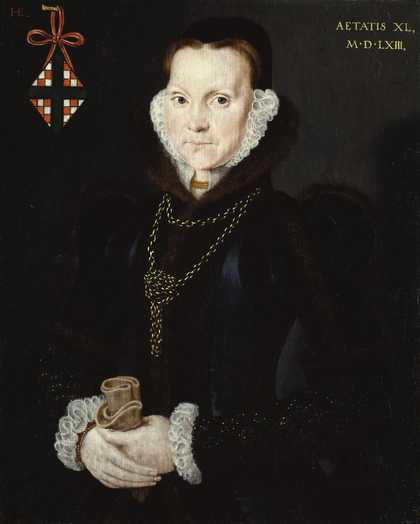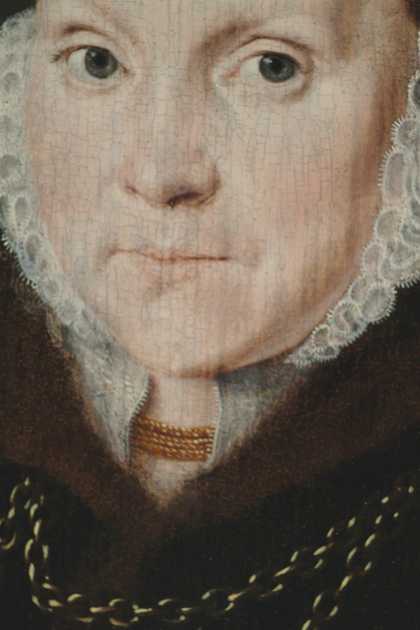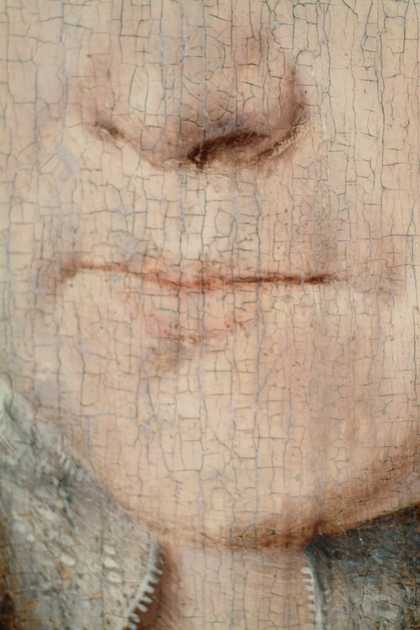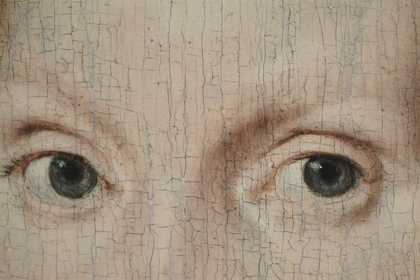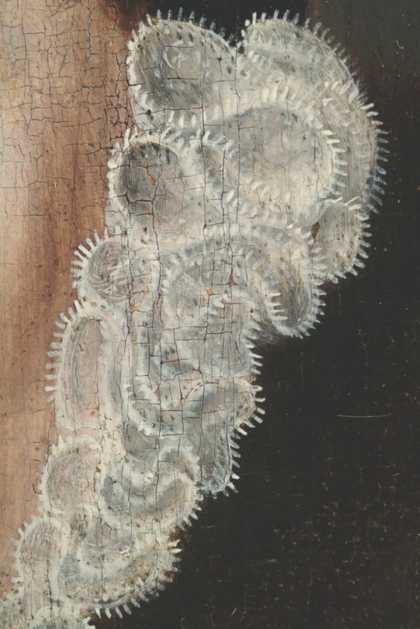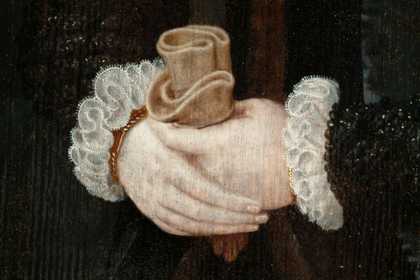This painting is in oil paint on a wooden panel measuring 378 x 392 mm (figs.1–6). The panel is composed of a single, radially cut, oak board, which is from 2 to 4 mm thick (figs.7–8). The back is neatly bevelled on the top, bottom and right edges, whereas on the left the bevel is present only on the lower half of the edge, due probably to the general unevenness in the thickness of the wood. Dendrochronological examination revealed an original additional fillet of wood on the upper left edge; it probably replaced some of the original sapwood. The oak board, which was cut from a tree that originated in the Baltic area, had a sequence of rings from 1400 to 1548. Allowing for the removal of sapwood from the board before use as a panel for painting, it is estimated that probable felling date was between 1556 and 1572.1 In 1973 an old loss of wood in the top left corner, measuring 41 x 5 mm, was filled with a section of oak with a similar grain.
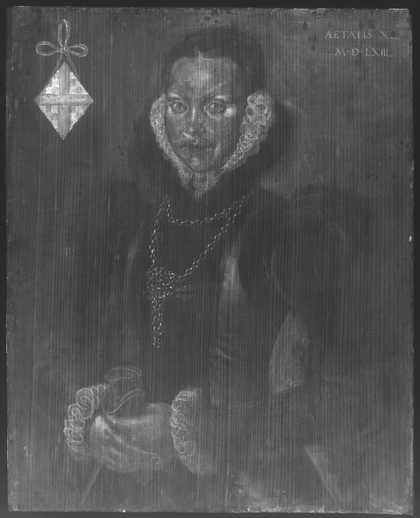
Fig.7
X-radiograph of Portrait of Elizabeth Roydon, Lady Golding
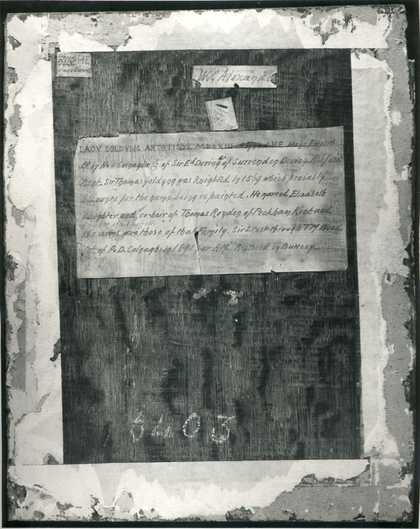
Fig.8
The back of Portrait of Elizabeth Roydon, Lady Golding, photographed in black and white
The ground is made of chalk and animal glue.2 White when first applied, it now appears yellowish where visible. It is covered over with thin, pale grey priming (figs.9–10). In cross-section the priming is a bright white matrix containing fine black and opaque red particles. In the past there was much cracking and cleavage of the preparation layers, possibly related to an excess of animal glue in the ground. In 1976 the painting was cleaned at the Tate in order to allow full consolidation of the loose ground. This treatment was the first since an earlier recorded clean and restoration in 1891 by Horace Buttery.
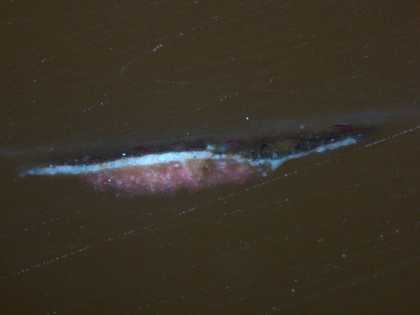
Fig.9
Cross-section through the green background, photographed at x225 magnification. From the bottom: white ground (which has been stained pink with acid fuchsin to identify the proteinaceous binding medium); pale grey priming; dark paint of background; varnish layers, part of which has stained with acid fuchsin
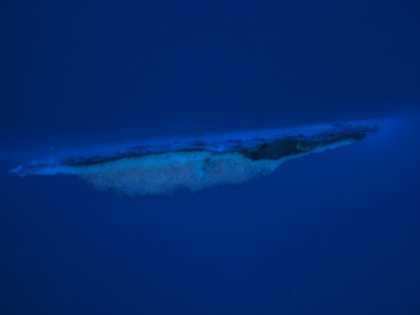
Fig.10
Cross-section through the green background, photographed at x225 magnification in ultraviolet light. From the bottom: white ground (which has been stained pink with acid fuchsin to identify the proteinaceous binding medium); pale grey priming; dark paint of background; varnish layers, part of which has stained with acid fuchsin
Infrared reflectography reveals much linear underdrawing in the face and hands (figs.11–12).
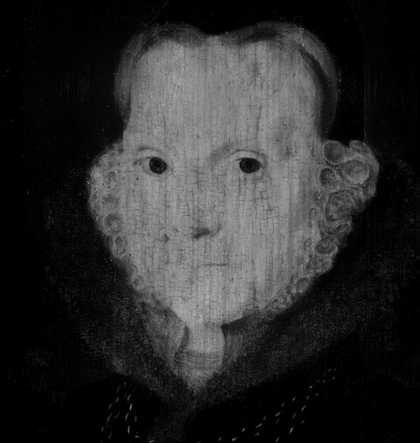
Fig.11
Infrared reflectograph detail of the face

Fig.12
Infrared reflectograph detail of hands
The paint was applied evenly and very thinly. Old abrasion right down to the ground in some areas reveals a simple build up. The background was painted smoothly wet-in-wet, after which detailing was applied on top, creating texture otherwise absent. Microscopic examination at the border of the figure suggests the background was painted first. Thin, fluid paint facilitates the smooth gradation from dark to lighter greenish grey in the background. The greenish grey tones were mixed from lead white, black, glassy particles, yellow earth colour, gypsum and umber.3 A cross-section from the bottom of the black skirt indicates that some underpainting exists in dark grey, followed by smooth application of the final black (figs.13–14). The black costume was made from bone black, lead white, chalk and glassy particles, the latter perhaps added to facilitate the drying of the oil, black pigments being ‘slow driers’ in this medium. Highlight and shadowing were scumbled in on top. Fine brushes were used to apply the regular short dashes of trim on the lace and the sheen on the chains. Still finer, pointed brushes created the individual hairs of the fur trim and black strokes at the peak of the hairpiece.

Fig.13
Cross-section through the black skirt, photographed at x225 magnification. From the bottom: white ground; pale grey priming at the right side of the sample; dark grey paint; black paint
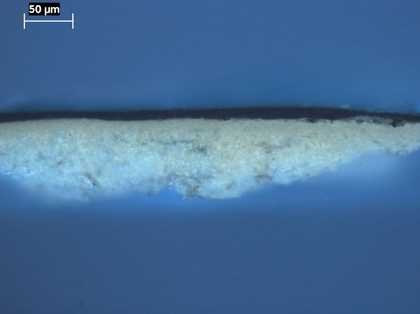
Fig.14
Cross-section through the black skirt, photographed at x225 magnification in ultraviolet light. From the bottom: white ground; pale grey priming at the right side of the sample; dark grey paint; black paint
The underdrawing is not strictly followed in the painting, and minor pentimenti in the painted image confirm that the artist allowed the image to evolve on the easel: the proper left side of the ruff was reduced and the left black sleeve extended.
The heraldic arms in the top left corner (known to be a later addition, see artwork summary) are applied in thicker, more opaque paint allowing individual brushstrokes to be apparent at the surface. The peg from which the arms hang is made from gold leaf. In contrast, in all original areas representing gold, the metal is described using yellow paint: the large, knotted chain, the bracelets and the several rows of the necklace.
July 2003

